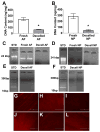Decellularization and characterization of a whole intervertebral disk xenograft scaffold
- PMID: 29673061
- PMCID: PMC6158084
- DOI: 10.1002/jbm.a.36434
Decellularization and characterization of a whole intervertebral disk xenograft scaffold
Abstract
Intervertebral disk (IVD) degeneration is a multifactor process that results in the physical destruction of the nucleus pulposus (NP) and annulus fibrosus (AF). This compromises IVD function and causes significant disability and economic burden. Strategies to replace the entire composite structure of the IVD are limited and most approaches do not recapitulate the heterogenous biochemical composition, microarchitecture or mechanical properties of the native tissue. Our central hypothesis was that donor IVDs which resemble the size and biochemistry of human lumbar IVDs could be successfully decellularized while retaining the tissue's structure and function with the long-term goal of creating a composite scaffold for tissue engineering the human IVD. Accordingly, we optimized a procedure to decellularize bovine tail IVDs using a combination of detergents, ultrasonication, freeze-thaw cycles, and nucleases. The resultant decellularized whole IVD xenografts retained distinct AF and NP regions which contained no visible intact cell nuclei and minimal residual bovine deoxyribose nucleic acid (DNA; 65.98 ± 4.07 and 47.12 ± 13.22 ng/mg, respectively). Moreover, the NP region of decellularized IVDs contained 313.40 ± 50.67 µg/mg glycosaminoglycan. The presence of collagen type II was confirmed via immunohistochemistry. Additionally, histological analysis of the AF region of decellularized IVDs demonstrated retention of the native angle-ply collagen microarchitecture. Unconfined compression testing demonstrated no significant differences in swelling pressure and toe-region modulus between fresh and decellularized IVDs. However, linear region moduli, peak stress and equilibrium moduli were all significantly reduced. Together, this research demonstrates a successful initial step in developing a biomimetic acellular whole IVD xenograft scaffold for use in IVD tissue engineering. © 2018 Wiley Periodicals, Inc. J Biomed Mater Res Part A: 106A:2412-2423, 2018.
Keywords: decellularization; intervertebral disk; scaffold; tissue engineering; xenograft.
© 2018 Wiley Periodicals, Inc.
Figures
References
-
- An HS, Thonar EJ-MA, Masuda K. Biological repair of intervertebral disc. Spine (Phila Pa 1976) 2003;28(15 Suppl):S86–92. - PubMed
-
- Rohlmann A, Zander T, Schmidt H, Wilke H-J, Bergmann G. Analysis of the influence of disc degeneration on the mechanical behaviour of a lumbar motion segment using the finite element method. J Biomech. 2006;39(13):2484–2490. - PubMed
Publication types
MeSH terms
Substances
Grants and funding
LinkOut - more resources
Full Text Sources
Other Literature Sources
Miscellaneous







